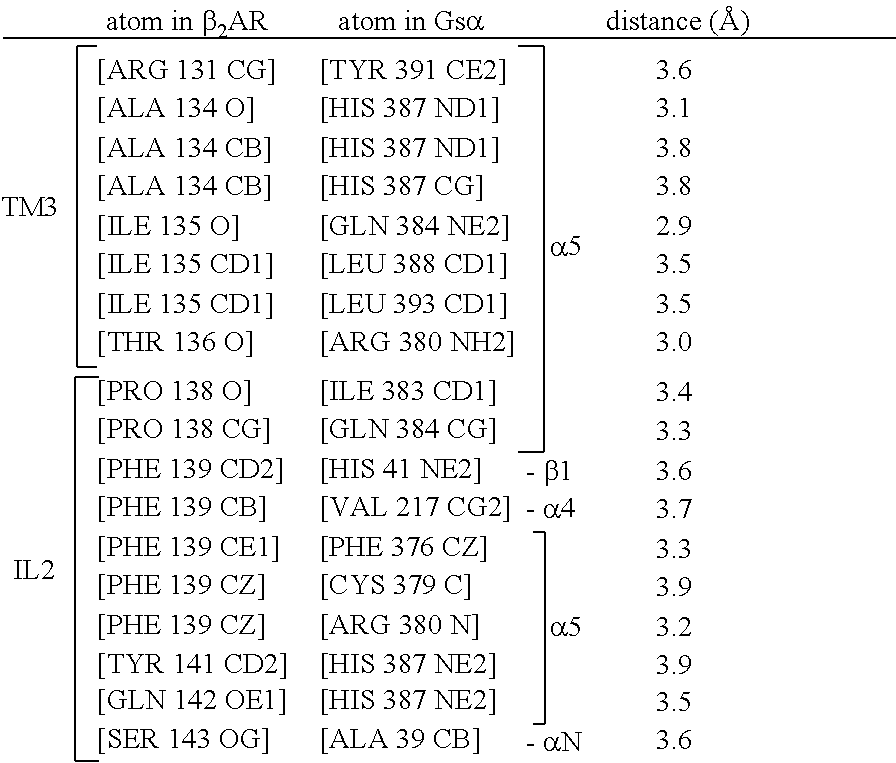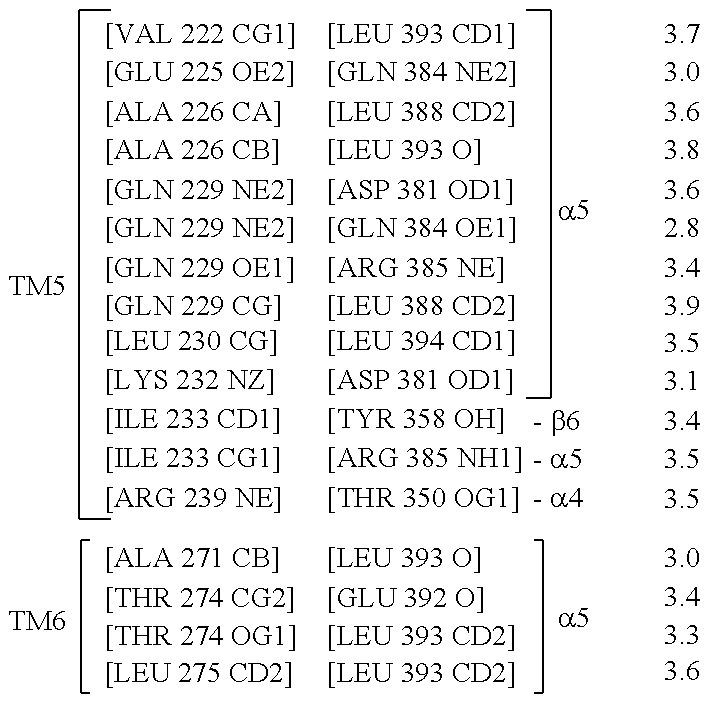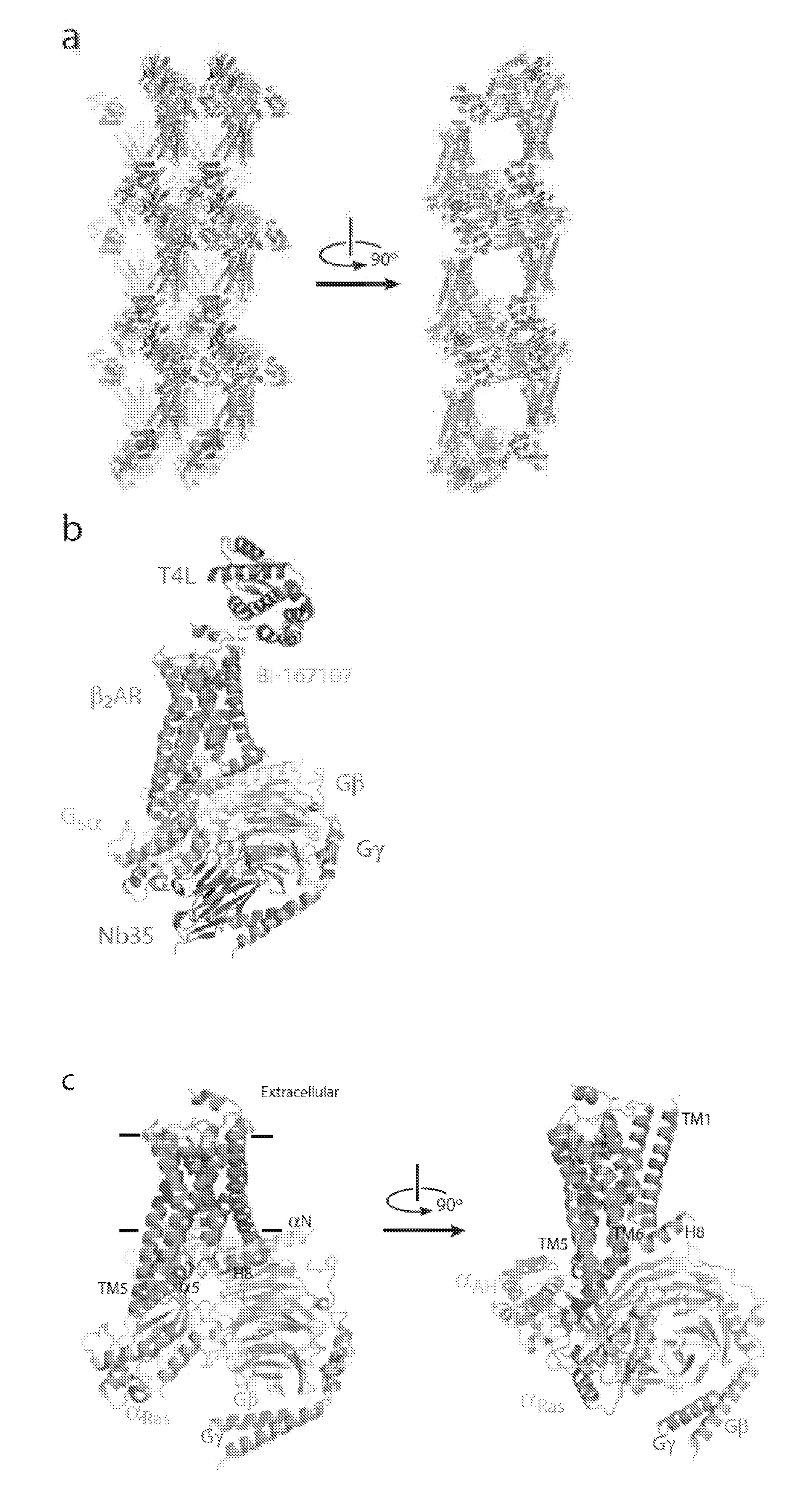Binding domains directed against gpcr:g protein complexes and uses derived thereof
a technology of gpcr and binding domain, applied in the field of gpcr structural biology and signaling, can solve the problems of difficult crystallogenesis of the complex, the state ternary complex composed of the agonist, the gpcr, etc., and achieve the effects of facilitating the identification of ligands, capturing and stabilizing other, and high affinity
- Summary
- Abstract
- Description
- Claims
- Application Information
AI Technical Summary
Benefits of technology
Problems solved by technology
Method used
Image
Examples
example 1
Formation and Purification of a Stable Agonist-β2AR-Gs Ternary Complex
[0284]Formation of a stable complex (see FIG. 2) was accomplished by mixing Gs heterotrimer at approximately 100 μM concentration with BI-167107 bound T4L-β2AR (or β2AR-365) in molar excess (approximately 130 μM) in 2 ml buffer (10 mM HEPES, pH 7.5, 100 mM NaCl, 0.1% DDM, 1 mM EDTA, 3 mM MgCl2, 10 μM BI-167107) and incubating for 3 hours at room temperature. BI-167107, which was identified from screening and characterizing approximately 50 different β2AR agonists, has a dissociation half-time of approximately 30 hours providing higher degree of stabilization to the active G protein-bound receptor than other full agonists such as isoproterenol (Rasmussen et al., 2011). To maintain the high-affinity nucleotide-free state of the complex, apyrase (25 mU / ml, NEB) was added after 90 min to hydrolyze residual GDP released from Gαs upon binding to the receptor. GMP resulting from hydrolysis of GDP by apyrase has very poor...
example 2
Generation of Nanobodies Binding to the Agonist:β2AR:Gs Ternary Complex
[0287]From negative stain EM imaging (data not shown), we observed that the alpha helical domain of Gαs was flexible. Targeted stabilization of this domain was addressed by generating nanobodies that bind to the agonist-β2AR-Gs ternary complex. Nanobodies are single domain antibodies, derived from heavy chain only antibodies from llamas (Muyldermans, 2001). To identify Nanobodies that bind the (agonist loaded) receptor coupled Gs-protein, we immunized two llamas (Llama glama) with the bis(sulfosuccinimidyl)glutarate (BS2G, Pierce) cross-linked β2AR:Gs:BI167107 ternary complex. Both animals were immunized with 4 bi-weekly shots of 50 to 100 μg. After completing the immunization, peripheral blood lymphocytes were isolated from the immunized animals to extract total RNA and prepare cDNA. Total RNA was isolated from about 107 lymphocytes as described by Chomczynski and Sacchi (1987). First strand cDNA synthesis was p...
example 3
Nb35, Nb36 and Nb37 Bind to Gs and Prevent Dissociation of the Complex by GTPγS
[0291]To determine if the Nanobodies raised against the β2AR:Gs:BI167107 ternary complex (Table 2) bind to the receptor or to Gs, we next monitored binding of these nanobodies in ELISA on purified receptor alone. All nanobodies from Table 2 scored negative in solid phase coated (Maxisorb, Nunc) agonist-bound β2AR-356 reconstituted at high density into phospholipid vesicles (Rasmussen et al., 2011). Nb80, a β2AR specific nanobody (Rasmussen et al., 2011) scored positive in this ELISA. None of the β2AR:Gs:BI167107 binders described in Table 2 bind the reconstituted receptor alone, indicating that they bind epitopes contained on Gs. Size exclusion chromatography shows that Nb35 and Nb37 bind separate epitopes on the Gs heterotrimer to form a R:G:Nb35:Nb37 complex (FIG. 3D). Similarly, Nb36 and Nb37 bind separate epitopes on the Gs heterotrimer to form a R:G:Nb36:Nb37 complex (FIG. 3E).
[0292]GDP, GTP and non-...
PUM
| Property | Measurement | Unit |
|---|---|---|
| affinity | aaaaa | aaaaa |
| conformational state | aaaaa | aaaaa |
| structure | aaaaa | aaaaa |
Abstract
Description
Claims
Application Information
 Login to View More
Login to View More - R&D
- Intellectual Property
- Life Sciences
- Materials
- Tech Scout
- Unparalleled Data Quality
- Higher Quality Content
- 60% Fewer Hallucinations
Browse by: Latest US Patents, China's latest patents, Technical Efficacy Thesaurus, Application Domain, Technology Topic, Popular Technical Reports.
© 2025 PatSnap. All rights reserved.Legal|Privacy policy|Modern Slavery Act Transparency Statement|Sitemap|About US| Contact US: help@patsnap.com



